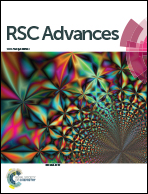Reduced fluorescence quenching of coumarin 102 at higher phenol mole fractions in cyclohexane–phenol and anisole–phenol solvent mixtures: role of competitive hydrogen bonding†
Abstract
Recently, we demonstrated that the fluorescence of coumarin 102 (C102) drastically quenches upon hydrogen bonding (H-bonding) with phenol in a non-polar solvent cyclohexane due to H-bond driven photoinduced electron transfer (PET) (J. Phys. Chem. A, 2013, 117, 3945–3953). However, the work was limited to low concentrations of phenol only, where predominately a 1 : 1 C102–phenol complex exists. Herein, we report an unusual fluorescence modulation of C102 over mole fractions of the H-bond donor (phenol) in the cyclohexane–phenol mixtures covering a higher range of mole fractions. We found that the fluorescence quantum yield (ϕf) and fluorescence lifetime (τf) of C102 first diminish steadily with increase in the concentration of phenol, but after a particular mole fraction (XPhOH = 0.013) both the quantities (ϕf and τf) increase upon further increase in the phenol content. The results can be attributed to the competitive nature of the C102–phenol and the phenol–phenol H-bonding. Since the PET quenching operates through the H-bond between the C![[double bond, length as m-dash]](https://www.rsc.org/images/entities/char_e001.gif) O group of C102 and the HO– group of phenol, the H-bond may fail to attain an optimum geometry when the phenol is linked with other phenols via the H-bond. The variation of the C102–phenol H-bonding nature with the mole fraction of phenol was supplemented by FT-IR measurements. Similar unusual variation of the C102 fluorescence is observed in the phenol–anisole mixtures to a lesser extent, but is completely absent in the anisole–cyclohexane mixtures, where H-bonding is practically impossible.
O group of C102 and the HO– group of phenol, the H-bond may fail to attain an optimum geometry when the phenol is linked with other phenols via the H-bond. The variation of the C102–phenol H-bonding nature with the mole fraction of phenol was supplemented by FT-IR measurements. Similar unusual variation of the C102 fluorescence is observed in the phenol–anisole mixtures to a lesser extent, but is completely absent in the anisole–cyclohexane mixtures, where H-bonding is practically impossible.


 Please wait while we load your content...
Please wait while we load your content...